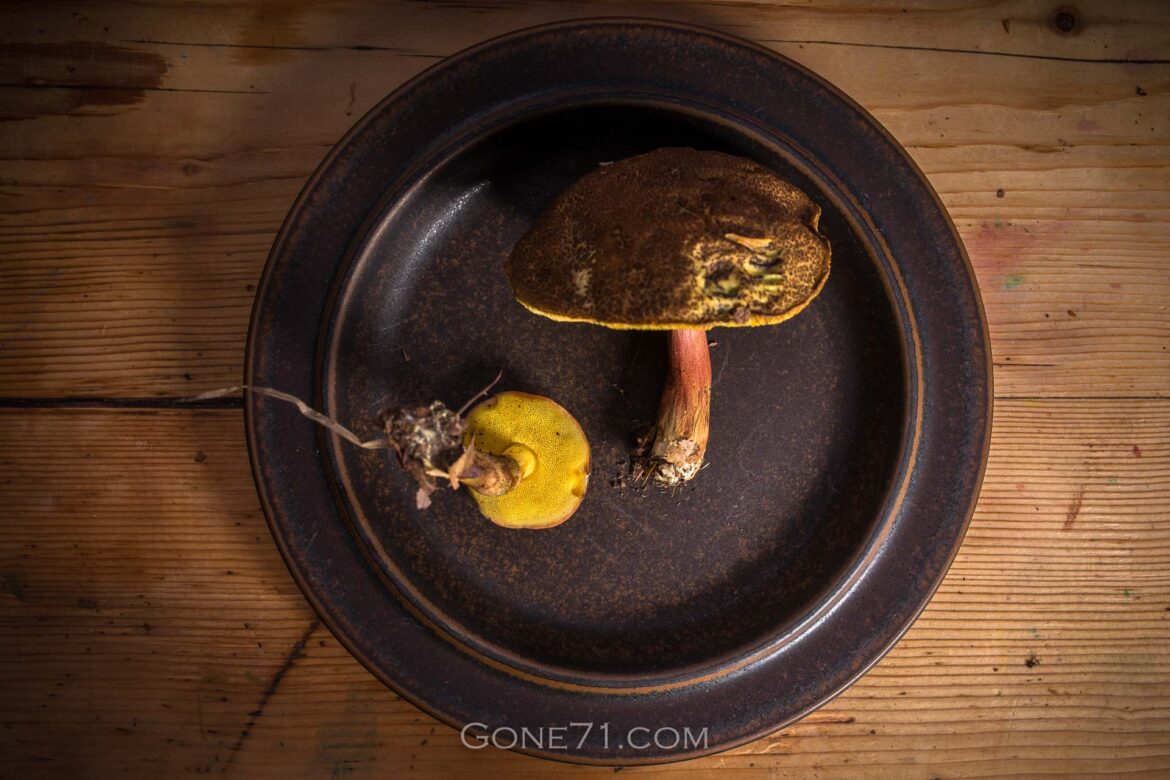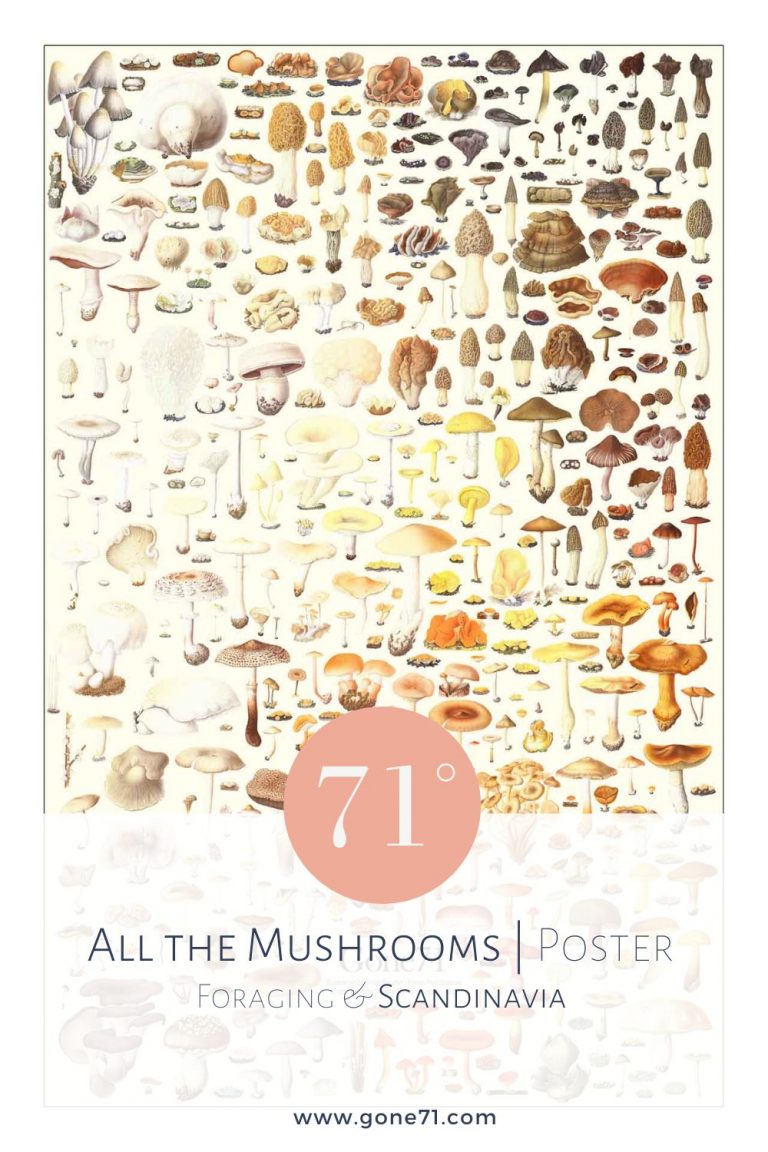swe.: Rutsopp | nor.: Ruterørsopp | fin.: Ruututatti | dt.: Rotfußröhrling, Rotfuß
„Among the toadstools which tradition would surely brand as poisonous on account of bright color is the common species [Yellow Fleshed Boletus | Boletus chrysonteron]. […] Stem yellow often brightly colored with the red of the cap Chance cracks in its surface become red whence the common name of the Red-cracked Boletus. A species frequent in woods throughout the summer and autumn and edible (William Hamilton Gibson, Our edible toadstoals… 1895).“
The red-cracking bolete is a mushroom that often occurs in abundance and is ignored by many mushroom pickers. Even as a child I was socialized in such a way that these mushrooms were considered inferior and were only collected in exceptional cases when nothing else could be found.
I have always found the young specimens in particular to be visually appealing, but since they were always considered inferior, I have paid very little attention to them. Until now that is.

One name many species – the “red-cracking boletes”
Many will (erroneously) group different types of mushrooms under the complex “red-cracking bolete”. We did (do) too.
On a recent mushroom excursion, I learned that to date there are 23 different types of red-cracked boletes. And this information came from someone who himself described one of these 23 species. That’s why I dare to accept this information even without in-depth research. In any case, there are too many to know them all as a normal mushroom enthusiast.
Most of them can probably only be distinguished under the microscope or by DNA analysis. Except for die-hard mycologists, such details are also irrelevant. Nevertheless, this has aroused my interest to deal more closely with these delicate creatures.
I can now macroscopically distinguish at least 5 different species that occur in my region (Central Europe).
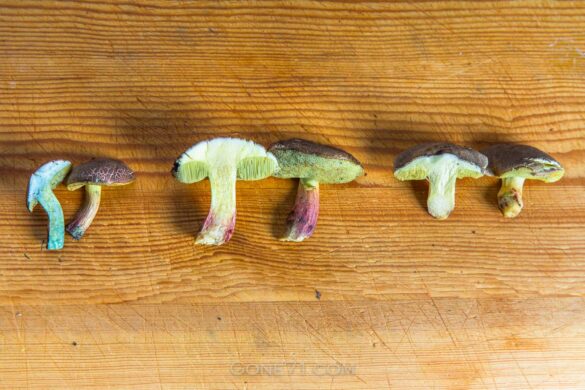
Different species of Xerocomellus (in Europe) often used interchangeably for red-cracking bolete
- Xerocomellus porosporus (Sepia bolte; dt.: Falscher Rotfußröhrling)
–> grey-yellow stem, only a few spots/colored reddish, mostly even total absence of red coloring on the stem, blackish to the base, stem turns blackish upon injury - Xerocomellus cisalpinus (dt.: Starkblauender Rotfußröhrling) –> When cut or injured, the flesh turns strongly blue
- Xerocomellus pruinatus (Matte bolete; dt.: Herbstrotfußröhrling)
–> thick stem, bright yellow flesh, flesh turns only slightly blue if at all - Xerocomellus chrysenteron (Red-cracking bolete, dt.: Gemeiner Rotfußröhrling)
–> stem is reddish dotted, flaky – without net drawing! strong cracking cap - Xerocomellus marekii (dt.: Rotfleischiger Rotfußröhrling)
–> Reddish dots at the base, flaky (without net). Flesh is reddish, can be mixed with slight blue colouring
Different species of Xerocomellus have different properties
As is so often the case, with knowledge comes the realization that you don’t know that much. Motivated by my new finds, which I previously largely dismissed as one species, I was also interested in the possibilities that this offers. It quickly became clear that in terms of culinary abilities, our favorite is X. pruinatus, the matte bolete. This bolete has thicker flesh and is much less likely to be attacked by insect larvae. Big disadvantage – it only grows in autumn and its availability is therefore very limited. But the common red-cracked bolete also got its chance with us.
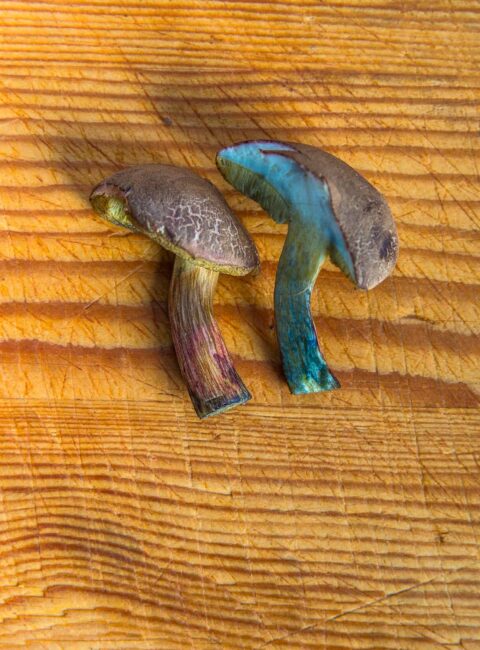
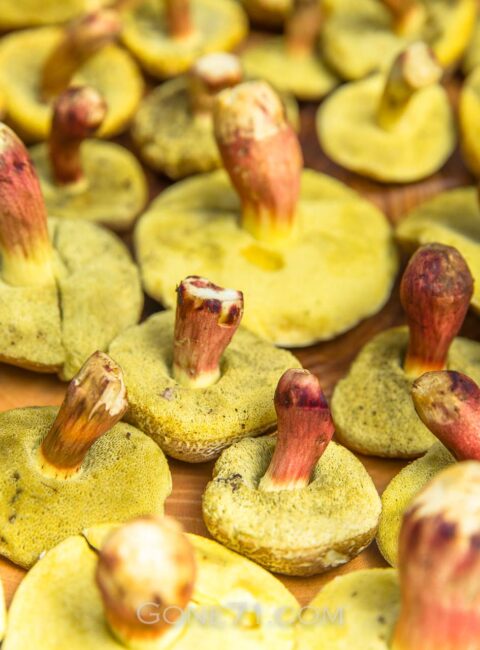
Appearance & habitat of the red-cracking bolete
An interesting detail is that only a few species grouped under red-cracking bolete actually have caps that crack. In addition to X. chrysenteron, the common red-cracking bolete – X. cisalpinus, the strong-blueing variation is one of them.
Red-cracking boletes grow from early summer through fall. They do not require any special soil conditions and can be found in both deciduous forests and conifers.
The cap skin is felty-brown and, at least in X. chrysenteron, is cracked with fissures in later stages. The flesh is generally yellow, sometimes bluing slightly but not as intensely as X. cisalpinus. The pores are lemon yellow when young, but turn olive greenish with age. When pressure is applied, they turn green-blue even in young specimens. The stem is red-flocked without mesh. In German, this characteristic is the eponymous chriterium (Rotfußröhrling = red footed boletus) and at the same time the umbrella term for all species of the genus Xerocommelus.

cap: brownish, felty, velvety, later torn open and traversed with the
eponymous cracks. Red coloring between the skin of the hat and the flesh.
flesh: yellow, sometimes slightly blue (not as strong as in X. cisalpinus). In
the case of the matte bolete, the flesh is usually of a more intense yellow.
pores: The pores are lemon yellow, turning greenish with age. When pressure and
injury occur, the pores turn greenish-blue.
stem: the stem is flocked reddish from the base up and has no mesh. The matte
bolete, on the other hand, has a thicker and firmer stem.
habitat: mixed forest
smell: neutral, slightly sour
taste: slightly sour
consumption: well cooked

Things to watch out for when collecting the red-cracking bolete
Unfortunately, the red-cracking bolete tends to be attacked by mold species such as the toxic bolete mold aka bolete eater (Hypomyces chrysospermus). Therefore, special care should be taken when collecting and individual specimens should be examined for mold infestation. Otherwise, you can get mushroom poisoning of a different kind. Red-cracking boletes are of particular interest when they are young and have solid fruiting bodies. If the cap can be pressed together with two fingers, the specimens are definitely too old.
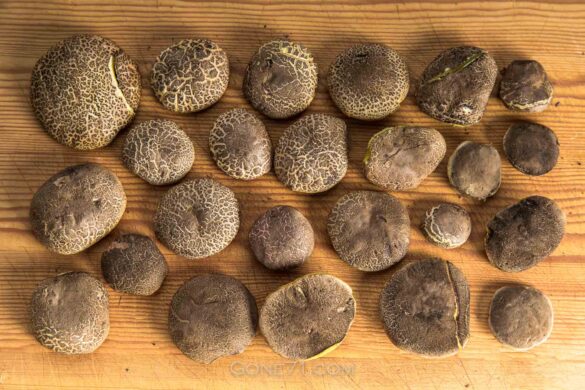
Lookalikes of the red-cracking bolete
Confusion mostly occurs with other species of Xerocomellus which most people treat as one species – e.g. sepia bolete (X. porosporus), X. cisalpinus, or the matte bolete (X. pruinatus). All varieties of the red-footed boletus are considered edible.
In addition, it can be confused with the also edible bay bolete (Imleria badia), the suede bolete (aka yellow cracking bolete, boring brown bolete, brown and yellow bolete | Xerocomus subtomentosus) and other species from the genus Xerocomus.
Another poisonous doppelganger for unwary foragers would be the bitter beech bolete aka scarlet-stemmed bolete (Caloboletus calopus).
Boring brown bolete aka brown and yellow bolete (Xerocomus subtomentosus)
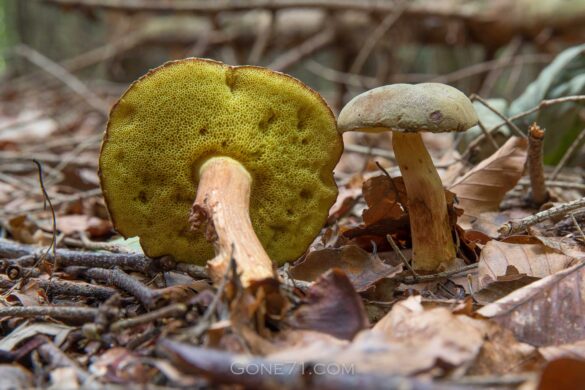
Bitter beech bolete (Caloboletus calopus) – be careful (poisonous)!
The bitter beech bolete is another bluing and slightly poisonous mushroom that has been known to be confused with the red-cracking bolete and other species of Xerocomellus. Despite its very attractive appearance, consumption can lead to longer-lasting gastrointestinal disorders.
The light brown-capped mushroom has intense yellow pores that turn blue when pressure is applied. The yellow stalk has a strong color gradient into red towards the base of the stem. The flesh is yellow and stains also blue when bruised or cut.
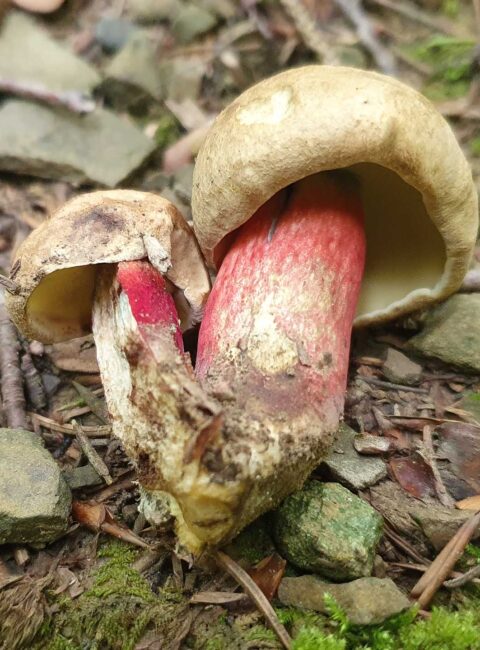
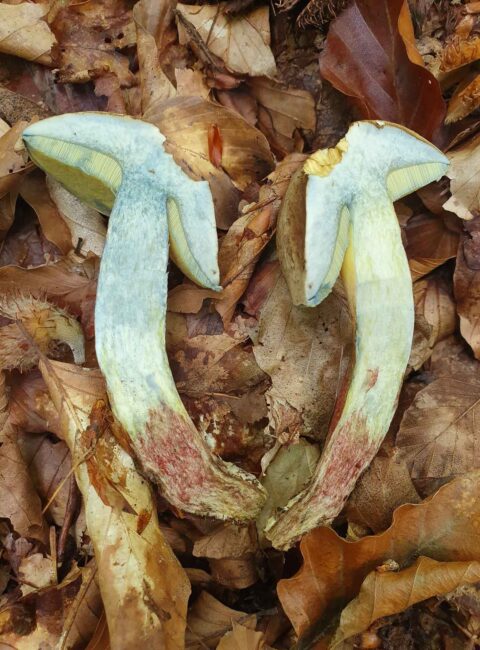
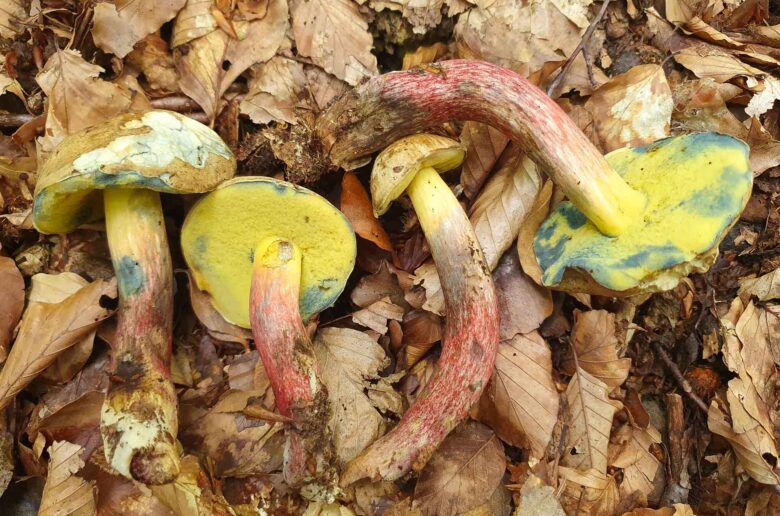
These are just a few of the potential sources of confusion and the list goes on.
Cleaning red-cracking boletes
The red-cracking boletes are cleaned with a knife just like other boletes. A damp cloth can be used for coarse dirt. In general, however, one should avoid the entry of moisture. That’s why we do not use water when cleaning boletes.
The pore layer on these mushrooms is often very thick and should also be removed from a culinary point of view, except for very young specimens.
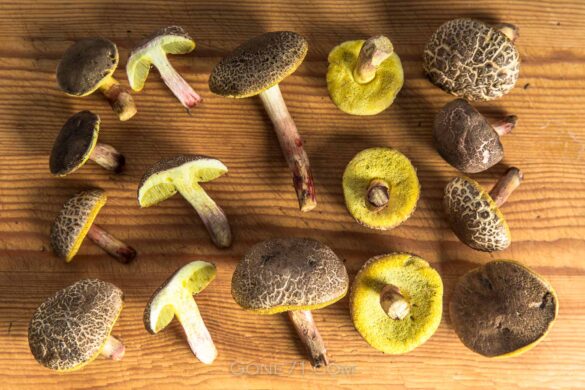
Red-cracking boletes in the kitchen
These mushrooms have a slightly sour taste. Most recipes and cooking recommendations say that it is (at most) suitable as a mixed mushroom. We don’t necessarily think so. Granted, you have to like the tart touch, but once you’re familiar with it, there’s nothing wrong with using this mushroom as the main protagonist in a dish.
We don’t want to sugarcoat anything here – it’s not porcini. On the other hand, the availability is usually very good due to the often massive occurrence from summer to autumn. It can be very worthwhile to be able to fall back on this mushroom, especially when themushroom season is not so productive. We only use very young specimens in the kitchen. The problem with mold infestation already mentioned at the beginning should really be taken very seriously. The young, firm fruit bodies are also much better in terms of taste.
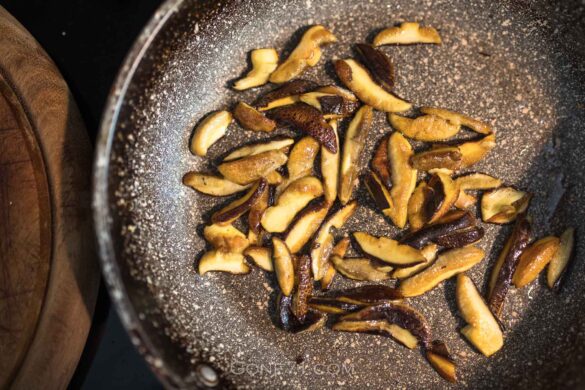
Red-cracking bolete recipe
For our recipe, we simply sautéed the red-cracking boletes with parsley and served them on dark rye crispbread. Granted, not really a recipe but an honest approach to give this mushroom the attention it deserves. If you would like more recipe ideas for this mushroom, you can also get inspiration from our recipe for the matte bolete.
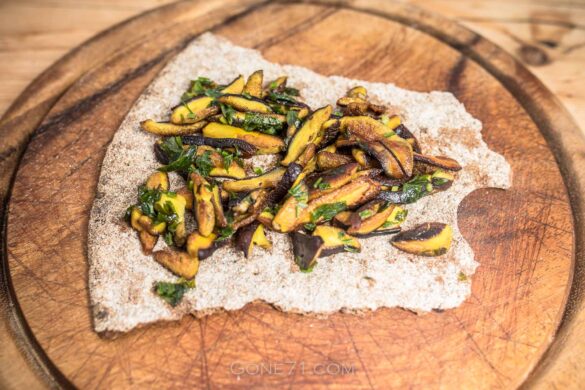
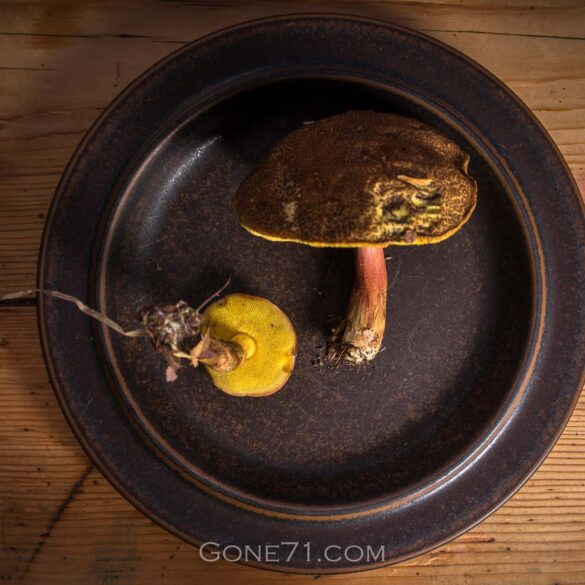
Red-cracking bolete recipe
Ingredients
- 400g red cracking boletes
- olive oil or butter
- salt, pepper
- parsley
- dark crispbread or something similar
Instructions
- Clean the mushrooms well and remove any dirt residue with a knife.
- Check for unwanted residents.
- Cut the mushrooms into thin pieces.
- Fry the mushrooms in olive oil for about 15 to 20 minutes.
- We prefer olive oil for cooking, but you can of course use butter if you like.
- Towards the end, season with salt and pepper and add the finely chopped parsley.
- Enjoy!
Notes
The recommendation for all Xerocomellus and Xerocomus mushrooms is to cook them for at least 15-20 minutes.
We have compiled this overview with the best of knowledge and belief, but do not claim to be complete and reserve the right to make errors.
Learn more about poisonous mushrooms and mushroom poisons here
↓↓↓
Find some inspiration in other mushroom recipes
↓↓↓


